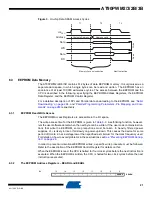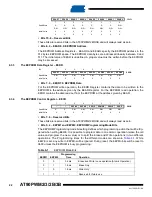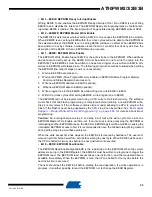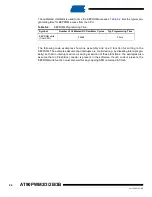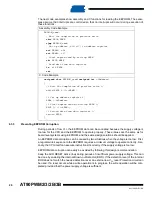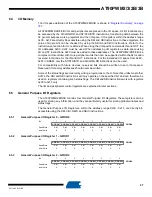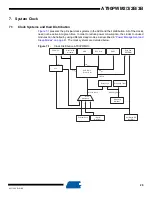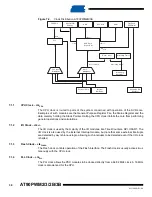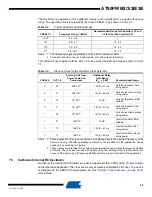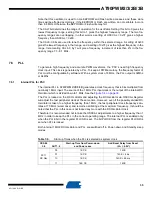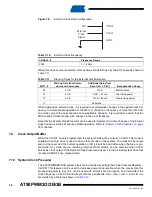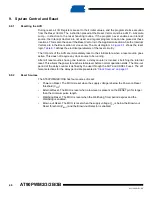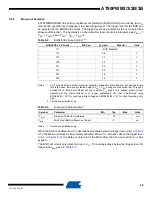
35
4317I–AVR–01/08
AT90PWM2/3/2B/3B
Note that this oscillator is used to time EEPROM and Flash write accesses, and these write
times will be affected accordingly. If the EEPROM or Flash are written, do not calibrate to more
than 8.8 MHz. Otherwise, the EEPROM or Flash write may fail.
The CAL7 bit determines the range of operation for the oscillator. Setting this bit to 0 gives the
lowest frequency range, setting this bit to 1 gives the highest frequency range. The two fre-
quency ranges are overlapping, in other words a setting of OSCCAL = 0x7F gives a higher
frequency than OSCCAL = 0x80.
The CAL6..0 bits are used to tune the frequency within the selected range. A setting of 0x00
gives the lowest frequency in that range, and a setting of 0x7F gives the highest frequency in the
range. Incrementing CAL6..0 by 1 will give a frequency increment of less than 2% in the fre-
quency range 7.3 - 8.1 MHz.
7.6
PLL
To generate high frequency and accurate PWM waveforms, the ‘PSC’s need high frequency
clock input. This clock is generated by a PLL. To keep all PWM accuracy, the frequency factor of
PLL must be configurable by software. With a system clock of 8 MHz, the PLL output is 32Mhz
or 64Mhz.
7.6.1
Internal PLL for PSC
The internal PLL in AT90PWM2/2B/3/3B generates a clock frequency that is 64x multiplied from
nominally 1 MHz input. The source of the 1 MHz PLL input clock is the output of the internal RC
Oscillator which is divided down to 1 MHz. See the
The PLL is locked on the RC Oscillator and adjusting the RC Oscillator via OSCCAL Register
will adjust the fast peripheral clock at the same time. However, even if the possibly divided RC
Oscillator is taken to a higher frequency than 1 MHz, the fast peripheral clock frequency satu-
rates at 70 MHz (worst case) and remains oscillating at the maximum frequency. It should be
noted that the PLL in this case is not locked any more with the RC Oscillator clock.
Therefore it is recommended not to take the OSCCAL adjustments to a higher frequency than 1
MHz in order to keep the PLL in the correct operating range. The internal PLL is enabled only
when the PLLE bit in the register PLLCSR is set. The bit PLOCK from the register PLLCSR is
set when PLL is locked.
Both internal 1 MHz RC Oscillator and PLL are switched off in Power-down and Standby sleep
modes
.
Table 7-9.
Start-up Times when the PLL is selected as system clock
CKSEL
3..0
SUT1..0
Start-up Time from Power-down
and Power-save
Additional Delay from Reset
(V
CC
= 5.0V)
0011
RC Osc
00
1K CK
14CK
01
1K CK
14CK + 4 ms
10
1K CK
14CK + 64 ms
11
16K CK
14CK
Содержание AT90PWM2
Страница 344: ...346 4317I AVR 01 08 AT90PWM2 3 2B 3B 31 1 SO24...
Страница 345: ...347 4317I AVR 01 08 AT90PWM2 3 2B 3B 31 2 SO32...
Страница 346: ...348 4317I AVR 01 08 AT90PWM2 3 2B 3B 31 3 QFN32...
Страница 347: ...349 4317I AVR 01 08 AT90PWM2 3 2B 3B...

